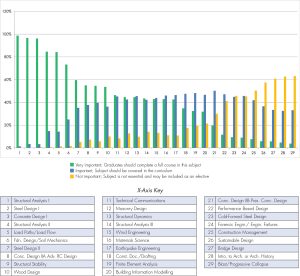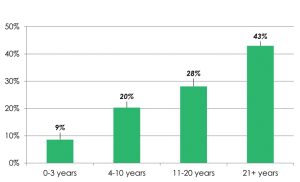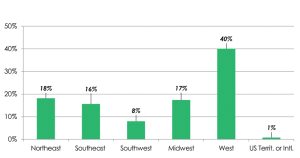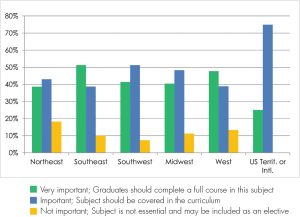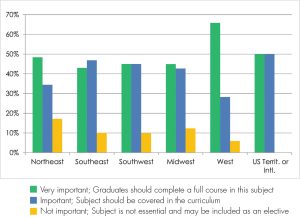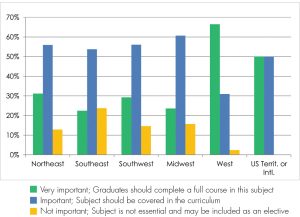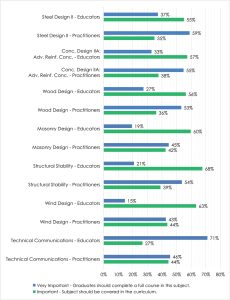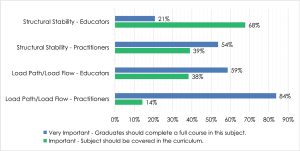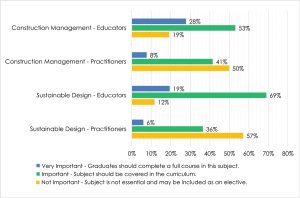What are Expectations for New Hires Entering the Workforce?
Structural engineering firms have a vested interest in selecting new hires with the skills to flourish in an office environment and an education that prepares them to solve the myriad of technical challenges that structural engineers encounter daily. Additionally, students who obtain an accredited degree from a civil/structural/architectural engineering program are interested in obtaining a job that applies their education and helps them advance their careers.
A Curriculum Survey was developed as a resource for structural engineering firms and students to better understand the education provided by universities. This survey provided the supply side of the equation but lacked the demand side. For example, what type of education do structural engineering firms desire and require of their new hires? A Practitioner Survey provides a resource to describe the skills and educational requirements that structural engineering firms value in new hires. Additionally, the focus of the Practitioner Survey was on the education of the structural engineering student and how it relates to real-world applications, industry demand, and technical preparedness.
The Basic Education Committee (BEC) published two surveys in 2016 related to the NCSEA recommended curriculum; the Curriculum Survey, which canvassed colleges and universities to gauge course offerings, and the Practitioner Survey, targeting design professionals to better understand the skills necessary to enter the structural engineering profession. In 2019 and 2021, the BEC launched new Curriculum and Practitioner surveys to better understand the issues and look for trends. Like previous surveys, they were administered via email and web links publicized by NCSEA. The 2019 curriculum survey article can be found on the BEC webpage https://bit.ly/3BCg1Ws, and the 2021 Practitioner Survey is summarized in this article.
Survey Overview
The 2016 and 2019 Curriculum Surveys focused on finding more information about the frequency and availability of the twelve (12) structural engineering courses recommended by NCSEA as core courses for structural engineering students.
Figure 1 shows the extent of the coursework and skills surveyed and the perceived importance indicated by the respondents.
Survey Results
The 2021 Practitioner Survey had a 24% increase in responses over the previous survey. Over 500 practitioner responses were received. The professional respondents’ experience distribution ranged from 0-3 years (8.6%) to over 21 years (43%). A full breakdown of this distribution can be seen in Figure 2.
The geographic distribution of responses throughout the United States was balanced amongst the practitioners between the Northeast, Southeast, Southwest, Midwest, and Western U.S. (Figure 3). Some respondents indicated their firm has multiple locations or their work is in multiple regions, which was considered when evaluating the data. The BEC presents this data to demonstrate that survey results reflect opinions from across the country. Although there were twice as many responses from the West, regional differences were insignificant except for a few topics discussed later in this article.
Except for Structural Analysis III (85%), Prestressed Concrete Design (70%), and Masonry Design (87%), more than 90% of the practitioners responding indicated the recommended curriculum topics should be included in or are very important to structural education.
As with the 2016 Practitioner survey, the 2021 survey’s highest-ranked non-core class or technical skill was Load Paths/Load Flow. Second to that was Structural Stability. Results of the Curriculum survey indicated that Load Paths/Load Flow are generally integrated into a group of design courses instead of being standalone courses. Notably, a few institutions have specific courses dedicated to loading, load paths for members/elements, building systems, and connection details. The importance of this topic and how the BEC will address this in the recommended course curriculum are noted below. The least ranked were Introduction to Architecture or Architecture History, Blast/Progressive Collapse, and Sustainable Design.
As mentioned above, the survey attempted to attract a distribution of respondents from across the structural engineering profession: practice work type, firm size, geographical region, and years of experience. The goal was to identify if these variables played a role in ranking the importance of topics for education in structures. The results showed that these variables were not a differentiator for “most important topics” such as Structural Analysis, Steel Design, Concrete Design, and Masonry Design. However, Wood Design and Earthquake Engineering were ranked about 20% higher in the Western region than in other regions (Figure 4a, 4b, and 4c). It should be noted that although the “Other U.S. Territories or International” responses show a significant difference, this region consisted of less than 1% of the responses, and the low number of respondents may have skewed the difference in response. Additionally, the survey successfully attracted a diverse sample of respondents, as shown in Figures 2 and 3. Most respondents primarily work on buildings, consistent with the NCSEA membership.
The Practitioner Survey provided the committee with insight through actual survey responses. However, personal comments by practitioners provided a greater understanding of how they value the education of structural engineering students and what they view as important to sustaining their profession and business. For example, technical communications and writing skills were strongly acknowledged in the 2016 survey responses, and this trend was noted to be even stronger in the 2020 survey. Additionally, when asked about the importance of including soft skills such as communication, creativity, flexibility, leadership, public speaking, and teamwork in the engineering curriculum, 44% thought these topics are very important, and a majority of course work should be spent on soft skills, 53% agreed that it was important but not a primary focal point. As one respondent explained:
“We have had students start at our firm with graduate degrees who were far less prepared for starting work than others who only had a 4-year undergraduate degree. A university education can only teach so much. It cannot make up for students lacking soft skills which should have been learned in High School. It cannot serve as a substitute for the very needed training and mentoring by their employer after graduation.” – practitioner
Most of the personal responses expressed views and opinions regarding the need for understanding load path, classical structural analysis methods, and interpreting results. Many practitioners also expressed the need for students to be involved with real-world applications, design projects, introduction to full building design and load path, and the building code and design process (Schematic Design, Design Development, Construction Documents, and Permitting). Detailing and construction techniques were common critiques mentioned by respondents.
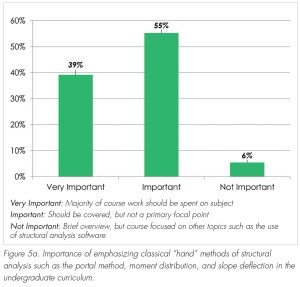
Likewise, many respondents (~43%) feel that basic knowledge and hand calculation methods are required. However, computer programming, modeling, and software are needed at the university level to complement students’ education (~57%). Figure 5a shows the response distribution from a question on the survey regarding classical calculation methods and computer modeling. From the responses, it can be derived that structural analysis and classical methods should not leave the curriculum. However, understanding structural behavior and interpreting computer analysis results are essential.
Like the previous Practitioner Survey, current survey results highlighted the need for students to bridge the gap between using computer models and successfully checking and understanding results (Figure 5b).
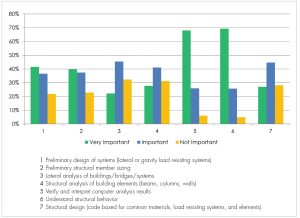
The Practitioner Survey also highlights the need for practical application of material topics, understanding the building code, and detailing and understanding building systems rather than just building elements. Furthermore, the education of structural engineering students is vital to sustaining and safeguarding the profession. Without proper training and knowledge, billable time is potentially affected, along with concerns for public safety.
Practitioner vs. Curriculum Surveys
The Practitioner and Curriculum survey participants were both asked to identify if the NCSEA Recommended Structural Engineering Curriculum courses and the additional subjects listed above were either 1) very important – graduates should complete a full course in this subject, 2) important – subject should be covered in the curriculum, or 3) not important for new graduates entering the workforce. The survey results indicate practitioners and educators agree on the recommended structural engineering coursework. However, a closer comparison of the Practitioner Survey and Curriculum Survey results yielded some identifiable differences.
For example, Figure 6a shows that while practitioners and educators both agree that Steel Design II, Concrete IIA: Advanced Reinforced Concrete Design, Wood Design, Masonry Design, Structural Stability, and Wind Design should be considered either a very important or important component of a structural engineer’s education, the practitioners generally felt that these courses needed a complete course in the subject while the educators felt that these courses should be covered in the curriculum but did not necessarily warrant a dedicated course. Technical Communications was also identified as either very important or important by both the practitioners and educators. Still, educators generally preferred that Technical Communications be taught in a dedicated course. In contrast, practitioners were agreeable to covering this topic as part of the curriculum but not necessarily as its own course.
As shown in Figure 6b, a significantly larger percentage of engineers felt a separate course was necessary for teaching both load paths/load flow and structural stability courses. At the same time, educators generally agreed that these courses were important but did not respond that they needed to be standalone courses. Sustainable Design and Construction Management were both viewed by educators as more essential topics than by practicing engineers, as indicated in Figure 6c.
Practitioner and educator survey participants were also surveyed about the preparedness of new graduates entering the workforce with the question, “Are new graduates and rising professionals with an undergraduate degree adequately prepared when entering the workforce?” Practitioners and educators overwhelmingly agreed that graduates with only an undergraduate degree are generally not prepared, with over 72 percent of practicing engineers and 83 percent of educators responding to the question with “Not so much – they have a general understanding but need more technical knowledge and skills.” Survey participants were also asked, “Are new graduates and rising professionals with a graduate degree adequately prepared when entering the workforce?” Eighty percent of educators and 62 percent of practitioners responded, “Most definitely – they have the tools and skills and are ready to perform entry-level structural engineering tasks.”
Summary
The BEC’s goal is to assess the surveys’ results to look for consensus and divergence of opinions between the academic and practicing professionals about the courses and topics students complete and how they prepare them to enter the workforce. One possible result of these surveys would be considering changing the recommended curriculum. Based on the survey results, this does not seem warranted at this time. However, a curriculum change alone will not satisfy nor meet all needs of the profession nor address the evolving nature of structural engineering. In addition, these courses are only one piece of the preparation, training, and skill requirements sought in graduating students by structural engineering firms. The survey responses help define where the structural engineering community seeks additional education. NCSEA will continue to look for gaps in student preparation and attempt to provide appropriate resources to fill these gaps and better serve the profession.
These surveys aim to influence the education topics for structural engineering students, promote continuing education of design professionals, and identify the qualifications of entry-level engineers who will shape the profession’s future. Ultimately, the BEC would like these surveys to be utilized by students, universities, and the structural engineering community. Additionally, the surveys provide an avenue to better understand educational requirements, raise awareness of the obstacles to providing the recommended curriculum, and hopefully, inspire the industry to support and augment student education.■
The NCSEA Recommended Structural Engineering Core Curriculum
- Structural Analysis I: Determinate Analysis
- Structural Analysis II: Indeterminate Analysis
- Structural Analysis III: Matrix Analysis
- Steel Design I
- Steel Design II
- Concrete Design I: Reinforced Concrete
- Concrete Design II
a) Concrete Design IIA: Advanced Reinforced Concrete
b) Concrete Design IIB: Prestressed Concrete - Wood Design
- Masonry Design
- Foundation Design/Soil Mechanics
- Structural Dynamics
- Technical Communications
The 2016 and 2021 Practitioner Surveys expanded on the recommended structural engineering curriculum by also looking at practitioner’s opinions on the importance of the following additional topics:
a) Load Paths/Load Flow
b) Cold-Formed Steel Design
c) Bridge Design
d) Structural Stability
e) Material Science
f) Earthquake Engineering
g) Sustainable Design
h) Finite Element Analysis
i) Wind Engineering
j) Blast/Progressive Collapse
k) Construction Management
l) Forensic Engineering/Engineering Failures
m) Performance-Based Design
n) Introduction to Architecture or Architecture History
o) Construction Documentation/Drafting
p) Building Information Modelling

